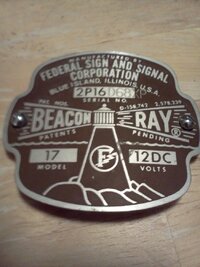Jordan said:
One thing I have seen also, is it seemed that Federal would print off the label with the common info(start of the batch of S/N's and mark the 17) but then depending on if it was a 173,174,175,176 they would then use the metal die to stamp the last numbers or letters. Though, what I could of been seeing is someone else modifying a model 17 tag to match a 17x light. I have seen more than 1 tag like what I described above.
Jordan,TCFD
I can vouch that Jordan knows his 175s. What I've seen on some 175s is the old tag with the 17 being prominent and the "5" being engraved next to it. Remember, in the earlier days when Federal started producing lights like the 173s, 1974s, 175s, and 176s, they were all variations off the original 17, and were built at someone's special request. Hence the engraved "5" next to the 17. Once some of these variations became popular and started to sell on their own, Federal assigned the above model numbers. Some other variations that didn't involve model designation changes included the California Special available on all of the lights. This was a single-faced, usually Unity, red sealed beam light mounted in the center of the base. This light was steady-burn to comply with California regulations.
As Federal explained in their old Catalog 300, a lot of variations came about as a result of differences in state laws. For example, one state would allow red to the front but not to the rear, so they had a split dome with red up front and blue or amber to the rear. As many differences as there were state requirements, Federal built accordingly. A friend of mine who has worked at a number of Southern California ambulance services sent me a picture a few years ago of a hightop Cadillac ambulance that had a pair of Federal 184 beacons on the front corners of the hightop. Both lights had split domes with red to the front and amber to the rear in accordance with California specs that required alternate amber lights to the rear. Anyone who ever watched "Emergency!" could see the slot cut out of the rear of their Twinsonic domes that had the amber bulbs. You could also see where the steady burning bulb behind the red dome was located. Only California could be so difficult. But there were a lot of variations in those days. I bought a 1967 hightop Olds ambulance in 1977 that had come from Lyons, Illinois. The big Olds had large tunnel lights over the cab and smaller ones built into the hightop. The tunnel light over the driver's side was green. This was a bulb/reflector ass'y, as there were no green sealed beams at the time. It was removed and replaced with a
Par-46 red sealed beam. Texas would've never allowed that green light back then. I had been told for years that Illinois required green on ambulances; but not long ago someone told me that wasn't true. I wonder why the had the green then!




